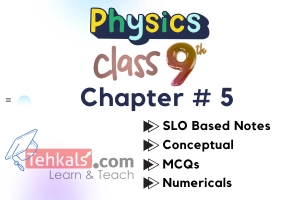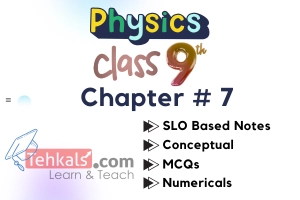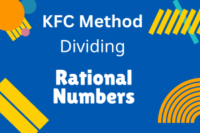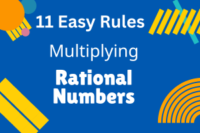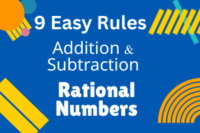Class 9 Physics Chapter 6
Published: 21 Oct 2023
Class 9 Physics Chapter 6 is about “Work and Energy“. This article includes topics such as Work, Energy and its Forms, Kinds of Energy (Kinetic Energy, Potential Energy), Energy and its forms, Energy Conversion and Conservation (A Diver on a Spring Board, Generation of Electricity, Pole Vault), Mass Energy Equivalence (Einstein’s Mass Energy Equation $ E=mc^2 $), Major Sources of Energy (Fossil Fuels, Bio-mass, Geothermal Energy, Wind Energy, Nuclear Energy, Solar Energy, Hydroelectric Generation), Efficiency and Power.
Class 9 Physics Chapter 6 Notes
Work and Energy Notes
Class 9 Physics Chapter 6 SLO Notes
Class 9 Physics Chapter 6 MCQs
Work
1 What is work in scientific terms?(a) Doing any activity
(b) Applying force without movement
(c) Applying force with movement in the same direction
(d) Applying force with movement in any direction
Show Answer
Applying force with movement in the same direction
2 Product of force and displacement covered in the direction of force is:
(a) Work
(b) Energy
(c) Power
(d) Efficiency
Show Answer
Work
3 When is maximum work considered to be done?
(a) When an object is lifted vertically
(b) When a force is applied at an angle to an object
(c) When there is motion in the opposite direction of the force
(d) When there is motion in the direction of the force
Show Answer
When there is motion in the direction of the force
4 Work is represented by………….
(a) W
(b) E
(c) P
(d) L
Show Answer
W
5 Which formula represents work $ (W) $ when force $ (F) $ moves an object over a displacement $ (S) $?
(a) $ W = F \times S $
(b) $ W = \frac{F}{S} $
(c) $ W = F + S $
(d) $ W = F – S $
Show Answer
$ W = F \times S $
6 What will be the magnitude of work if a force of $ 25 N $ pulls a stone through a distance of $ 5 m $ in its direction:
(a) 25 J
(b) 50 J
(c) 75 J
(d) 125 J
Show Answer
125 J
7 Suppose a person exerts a force of $ 50 N $ to push a box a distance of $ 5 meters $. Calculate the work done.
(a) 25 J
(b) 250 J
(c) 50 J
(d) 500 J
Show Answer
250 J
8 A person does 600 joules of work while lifting a box a distance of 3 meters vertically. What is the force exerted by the person?
(a) 25 N
(b) 50 N
(c) 75 N
(d) 200 N
Show Answer
200 N
9 What is the unit of work?
(a) Joule (J)
(b) Newton (N)
(c) Meter (m)
(d) Second (s)
Show Answer
Joule (J)
10 Which unit is equal to $ kgm^2s^2 $ in the units given below:
(a) Newton
(b) Watt
(c) Joule
(d) Meter
Show Answer
Joule
11 The unit of work, joule $ (J) $, is equal to:
(a) 1 Newton-meter $ (1 Nm) $
(b) 1 meter per second $ (1 m/s) $
(c) 1 Newton per meter $ (1 N/m) $
(d) 1 kilogram per second $ (1 kg/s) $
Show Answer
1 newton-meter $ (1 Nm) $
12 When is work positive?
(a) When force and motion are in opposite directions
(b) When force and motion are at right angles
(c) When force and motion are in the same direction
(d) When there is no motion despite applied force
Show Answer
When force and motion are in the same direction
13 When is work negative?
(a) When force and motion are in opposite directions
(b) When force and motion are at right angles
(c) When force and motion are in the same direction
(d) When there is no motion despite applied force
Show Answer
When force and motion are in opposite directions
14 What is the SI unit of force?
(a) Kilogram (kg)
(b) Joule (J)
(c) Newton (N)
(d) Meter (m)
Show Answer
Newton (N)
15 Work done will be one ………. if a force of 1 Newton acts on the body and it covers the distance of 1 meter in the direction of force:
(a) Watt
(b) Joule
(c) Newton
(d) Coulomb
Show Answer
Joule
16 One Mega joule is equal to:
(a) $ 10^3 J $
(b) $ 10^4 J $
(c) $ 10^5 J $
(d) $ 10^6 J $
Show Answer
$ 10^6 J $
17 Work is a…………..quantity:
(a) Scalar
(b) Vector
(c) Base
(d) All of these
Show Answer
Scalar
18 Work is considered a scalar quantity because:
(a) It involves both magnitude and direction
(b) It only involves magnitude, not direction
(c) It can be negative but not positive
(d) It is measured in kilograms
Show Answer
It only involves magnitude, not direction
19 Work done will be ………. if no force acts on the body:
(a) Maximum
(b) Minimum
(c) Zero
(d) All of these
Show Answer
Zero
20 Work done will be maximum if displacement is ………… to force:
(a) Parallel
(b) Perpendicular
(c) Tangent
(d) All of these
Show Answer
Parallel
21 Work done will be zero if displacement is ………… to Force:
(a) Parallel
(b) Perpendicular
(c) Tangent
(d) Normal
Show Answer
Perpendicular
22 Which situation represents more work being done?
(a) A girl pushing a box across the floor
(b) A boy standing still and holding a box
(c) A person carrying a backpack while walking
(d) A person sleeping on a bed
Show Answer
A girl pushing a box across the floor
23 How work is calculated when a force applied at an angle to the direction of motion?
(a) $ W = F \times S $
(b) $ W = \frac{F}{S} $
(c) $ W = F \times S × cos(\theta) $
(d) $ W = F \times S × sin(\theta) $
Show Answer
$ W = F \times S × cos(\theta) $
Energy
24 Ability of a body to do work is known as:(a) Force
(b) Momentum
(c) Power
(d) Energy
Show Answer
Energy
25 Unit of Energy in System International is:
(a) Watt
(b) Joule
(c) Newton
(d) Coulomb
Show Answer
Joule
26 Energy is represented by …………….
(a) W
(b) P
(c) E
(d) L
Show Answer
E
27 Energy is a…………..quantity:
(a) Vector
(b) Scalar
(c) Base
(d) None of these
Show Answer
Scalar
To Download Complete Notes of Physics Notes 9 Class, Click on the given link.
Kinds of Energy
28 There are ………… basic kinds of energy:(a) 1
(b) 2
(c) 3
(d) 4
Show Answer
2
29 How are the different forms of energy classified?
(a) As either sun or heat energy
(b) As either potential or kinetic energy
(c) As either heavy or light energy
(d) As either fast or slow energy
Show Answer
As either potential or kinetic energy
Kinetic Energy
30 Which of the following scenarios contributes to an object’s kinetic energy?(a) A stationary car
(b) A stationary ball
(c) A moving cricket ball
(d) A stationary building
Show Answer
A moving cricket ball
31 What determines the ability of a moving object to do work?
(a) Its mass
(b) Its color
(c) Its shape
(d) Its temperature
Show Answer
Its mass
32 How kinetic energy is mathematically calculated?
(a) $ K.E = mv $
(b) $ K.E = 2mv $
(c) $ K.E = \frac{1}{2} mv^2 $
(d) $ K.E = mv^2 $
Show Answer
$ K.E = \frac{1}{2} mv^2 $
33 A bowler during playing cricket throws a ball of mass $ 2 kg $ with a velocity of $ 2 m/s $. Its kinetic energy will be:
(a) 4 J
(b) 40 J
(c) 400 J
(d) 4000 J
Show Answer
4 J
34 What will be the kinetic energy of a car of mass $ 10 kg $ moving with a velocity of $ 2 m/s $?
(a) 20000 J
(b) 2000 J
(c) 200 J
(d) 20 J
Show Answer
20 J
35 What will be the kinetic energy of a body if its velocity is doubled?
(a) Doubled
(b) Four times
(c) Eight times
(d) Half
Show Answer
Four times
36 What will be the kinetic energy of a body if its velocity is half?
(a) Doubled
(b) Four times
(c) Eight times
(d) One fourth
Show Answer
One fourth
37 What will be the kinetic energy of a body if its mass is doubled?
(a) Doubled
(b) Four times
(c) Eight times
(d) Half
Show Answer
Doubled
38 What will be the kinetic energy of a body if its mass is half?
(a) Doubled
(b) Four times
(c) Eight times
(d) Half
Show Answer
Half
39 What will be the kinetic energy of a body if it’s both mass and velocity are doubled?
(a) Doubled
(b) Four times
(c) Eight times
(d) One fourth
Show Answer
Eight times
40 When comparing two cricket balls moving towards you, which one can potentially do more work?
(a) The ball with larger mass
(b) The ball with smaller mass
(c) The ball with smaller speed
(d) Both balls have the same kinetic energy
Show Answer
The ball with larger mass
41 Kinetic energy depends on……………. factors.
(a) 1
(b) 2
(c) 3
(d) 4
Show Answer
2
Potential Energy
42 Ability of a body to do work due to its position is called:(a) Kinetic
(b) Potential
(c) Mechanical
(d) All of these
Show Answer
Potential
43 Ability of a body to do work due to its height from the surface of earth is called:
(a) Gravitational Potential
(b) Elastic Potential
(c) Chemical Potential
(d) Attraction
Show Answer
Gravitational Potential
44 When a ball is lifted to a height ‘h’ from the ground, it will possess…………..energy:
(a) Kinetic
(b) Gravitational potential
(c) Mechanical
(d) Elastic potential
Show Answer
Gravitational Potential
45 Which type of potential energy is stored in a book placed on a high shelf?
(a) Gravitational potential energy
(b) Elastic potential energy
(c) Chemical potential energy
(d) All of these
Show Answer
Gravitational potential energy
46 Which form of potential energy is stored in food?
(a) Gravitational potential energy
(b) Elastic potential energy
(c) Chemical potential energy
(d) All of these
Show Answer
Chemical potential energy
47 When an elastic band is stretched, what type of potential energy is stored in it?
(a) Gravitational potential energy
(b) Elastic potential energy
(c) Chemical potential energy
(d) All of these
Show Answer
Elastic potential energy
48 What is the mathematical expression for gravitational potential energy?
(a) $ P.E = m \times g \times h $
(b) $ P.E = F \times s $
(c) $ P.E = mv^2 $
(d) $ P.E = E \times t $
Show Answer
$ P.E = m \times g \times h $
49 What is the amount of energy stored when lifting a $ 0.3 kg $ brick to a height of $ 2 m $ against gravity?
(a) $ 2.94 J $
(b) $ 5.88 J $
(c) $ 8.82 J $
(d) $ 10.76 J $
Show Answer
$ 5.88 J $
50 Gravitational potential energy is the product of:
(a) Mass, acceleration, and height
(b) Force, velocity, and time
(c) Distance, time, and velocity
(d) Mass, velocity, and distance
Show Answer
Mass, acceleration, and height
51 Gravitational potential energy is a scalar quantity. What does this mean?
(a) It has both magnitude and direction
(b) It only has magnitude
(c) It only has direction
(d) It has neither magnitude nor direction
Show Answer
It only has magnitude
52 What is the work done against the force of gravity when lifting an object?
(a) $ W = F \times d $
(b) $ W = m \times g \times h $
(c) $ W = P \times t $
(d) $ W = KE + PE $
Show Answer
$ W = m \times g \times h $
53 The work done against gravity to lift an object is stored as:
(a) Gravitational potential energy
(b) Kinetic energy
(c) Elastic potential energy
(d) Mechanical energy
Show Answer
Gravitational potential energy
54 Gravitational potential energy depends on…………….factors.
(a) 1
(b) 2
(c) 3
(d) 4
Show Answer
3
Forms of Energy
Chemical Energy
55 What type of energy is contained within the bonds between atoms?(a) Gravitational energy
(b) Chemical energy
(c) Kinetic energy
(d) Radiant energy
Show Answer
Chemical energy
Radiant Energy
56 Which form of energy travels as an electromagnetic (light) wave?(a) Gravitational energy
(b) Chemical energy
(c) Kinetic energy
(d) Radiant energy
Show Answer
Radiant energy
Light Energy
57 What is the source of energy for processes like photosynthesis in plants?(a) Gravitational energy
(b) Light energy
(c) Kinetic energy
(d) Sound energy
Show Answer
Light energy
Electrical Energy
58 What type of energy is associated with charges and involves the movement of electrons?(a) Chemical energy
(b) Radiant energy
(c) Electrical energy
(d) Nuclear energy
Show Answer
Electrical energy
Heat Energy
59 Which type of energy transfer occurs when energy travels from a hot body to a cold body?(a) Electrical energy
(b) Radiant energy
(c) Sound energy
(d) Heat energy
Show Answer
Heat energy
60 What type of energy is transferred when a fire burns and warms up a room?
(a) Electrical energy
(b) Radiant energy
(c) Sound energy
(d) Heat energy
Show Answer
Heat energy
Sound Energy
61 What causes atoms or molecules to vibrate back and forth in a substance, producing sound energy?(a) Chemical reactions
(b) Radiant energy
(c) Electrical current
(d) Sound waves
Show Answer
Sound waves
Nuclear Energy
62 What kind of energy is associated with the nucleus of an atom?(a) Chemical energy
(b) Nuclear energy
(c) Radiant energy
(d) Heat energy
Show Answer
Nuclear energy
63 How is nuclear energy utilized in nuclear power stations?
(a) To generate sound energy
(b) To generate electrical energy
(c) To create radiant energy
(d) To produce chemical reactions
Show Answer
To generate electrical energy
Energy Conversion
Law of Conservation of Energy
A Driver on a Spring Board
Generator of Electricity
Pole Vault
64 According to the law of conservation of energy, what happens to the total amount of energy in any process?(a) It can be converted but remains constant
(b) It can be created and destroyed
(c) It can only be created
(d) It can only be destroyed
Show Answer
It can be converted but remains constant
65 How is energy conversion from one form to another described by the law of conservation of energy?
(a) Energy is created in the process
(b) Energy is destroyed in the process
(c) Energy remains constant throughout the process
(d) Energy is randomly transformed
Show Answer
Energy remains constant throughout the process
66 In the case of a diver on a springboard, which type of energy is stored in the body of the diver?
(a) Gravitational potential energy
(b) Kinetic energy
(c) Elastic potential energy
(d) Chemical energy
Show Answer
Chemical energy
67 What form of energy is stored in a bent diving board after the diver bends it?
(a) Gravitational potential energy
(b) Kinetic energy
(c) Elastic potential energy
(d) Chemical energy
Show Answer
Elastic potential energy
68 How is the potential energy of water stored at a height converted into electricity?
(a) Through nuclear reactions
(b) Through chemical reactions
(c) By making it fall on a turbine
(d) By heating the water
Show Answer
By making it fall on a turbine
69 What energy conversion takes place when a pole vaulter runs and plants the pole to vault over a bar?
(a) Kinetic energy to potential energy
(b) Potential energy to kinetic energy
(c) Elastic potential energy to gravitational potential energy
(d) Gravitational potential energy to kinetic energy
Show Answer
Kinetic energy to potential energy
70 When a weightlifter lifts a barbell over her head, what type of energy is primarily used?
(a) Kinetic energy
(b) Gravitational potential energy
(c) Elastic potential energy
(d) Chemical energy
Show Answer
Chemical energy
71 For maintaining the body temperature, what type of energy is used?
(a) Heat
(b) Electrical
(c) Chemical
(d) Mechanical
Show Answer
Heat
72 What type of energy is stored in the water stored in a dam?
(a) Elastic potential energy
(b) Gravitational potential energy
(c) Kinetic energy
(d) Mechanical energy
Show Answer
Gravitational potential energy
73 Increase in K.E is equal to:
(a) Increase in P.E
(b) Decrease in P.E
(c) Both A & B
(d) None of these
Show Answer
Decrease in P.E
74 Increase in P.E is equal to:
(a) Increase in K.E
(b) Decrease in K.E
(c) Both A & B
(d) None of these
Show Answer
Decrease in K.E
75 Decrease in K.E is equal to:
(a) Increase in P.E
(b) Decrease in P.E
(c) Both A & B
(d) None of these
Show Answer
Increase in P.E
76 Decrease in P.E is equal to:
(a) Increase in K.E
(b) Decrease in K.E
(c) Both A & B
(d) None of these
Show Answer
Increase in K.E
Mass Energy Equivalence
Einstein’s Energy Mass Equation
77 What is $ Einstein’s \ mass-energy $ equation?(a) $ E = mc $
(b) $ E = mc^2 $
(c) $ E = mc^3 $
(d) $ E = mc^4 $
Show Answer
$ E = mc^2 $
78 In Einstein’s equation $ E = mc^2 $, what does $ “E” $ represent?
(a) Energy
(b) Mass
(c) Speed of light
(d) Momentum
Show Answer
Energy
79 What is the unit of energy in Einstein’s equation $ E = mc^2 $?
(a) Joules $ (J) $
(b) Kilograms $ (kg) $
(c) Meters per second $ (m/s) $
(d) Watts $ (W) $
Show Answer
Joules $ (J) $
80 What does $ “m” $ represent in Einstein’s equation $ E = mc^2 $?
(a) Energy
(b) Mass
(c) Speed of light
(d) Momentum
Show Answer
Mass
81 What is the constant value of the speed of light in meters per second $ (m/s) $?
(a) $ 1 \times 10^6 m/s $
(b) $ 3 \times 10^8 m/s $
(c) $ 5 \times 10^{10} m/s $
(d) $ 9 \times 10^{12} m/s $
Show Answer
$ 3 \times 10^8 m/s $
82 How is the speed of light represented in Einstein’s equation $ E = mc^2? $
(a) $ s $
(b) $ v $
(c) $ c $
(d) $ a $
Show Answer
$ c $
83 According to Einstein’s mass-energy equivalence, what physical entities are the same and can be changed into each other?
(a) Mass and energy
(b) Mass and momentum
(c) Mass and speed
(d) Mass and force
Show Answer
Mass and energy
84 In Einstein’s equation, what is the relationship between energy and mass?
(a) Energy is inversely proportional to mass
(b) Energy is equal to mass
(c) Energy is proportional to mass
(d) Energy is the square root of mass
Show Answer
Energy is proportional to mass
85 What are the units of the speed of light $ (c) $ in Einstein’s equation?
(a) $ m/s $
(b) $ m/s^2 $
(c) $ m^2/s^2 $
(d) $ m^3/s^3 $
Show Answer
$ m/s $
Major Sources of Energy
Fossil Fuels
Bio-mass
Geothermal Energy
Wind Energy
Nuclear Energy
Solar Energy
Hydroelectric Generation
86 What is the term for the transformation of energy from one source into a useful form?(a) Energy exchange
(b) Energy utilization
(c) Energy transformation
(d) Energy conversion
Show Answer
Energy transformation
87 Which of the following is NOT a major source of energy?
(a) Geothermal energy
(b) Solar energy
(c) Wind energy
(d) Food energy
Show Answer
Food energy
88 Which of the following is a fossil fuel?
(a) Biomass
(b) Geothermal energy
(c) Natural gas
(d) Nuclear energy
Show Answer
Natural gas
89 Which energy source is associated with the remains of ancient plant and animal life?
(a) Geothermal energy
(b) Fossil fuel
(c) Wind energy
(d) Nuclear energy
Show Answer
Fossil fuel
90 Fossil fuels are consumed in more than ………. of the world demand for energy.
(a) 80 %
(b) 90 %
(c) 50 %
(d) 10 %
Show Answer
80 %
91 What is the most abundant fossil fuel in the world?
(a) Oil
(b) Natural gas
(c) Coal
(d) Petroleum
Show Answer
Coal
92 What process is used to convert crude oil into products like gasoline and heating oil?
(a) Fission
(b) Photosynthesis
(c) Refinement
(d) Combustion
Show Answer
Refinement
93 What is the primary advantage of natural gas as an energy source?
(a) It produces no waste gases
(b) It is abundant in supply
(c) It is easy to transport
(d) It is a renewable resource
Show Answer
It is easy to transport
94 Which type of energy resource is produced when solar energy is converted into plant matter?
(a) Fossil fuels
(b) Nuclear energy
(c) Geothermal energy
(d) Biomass
Show Answer
Biomass
95 Which of the following is an example of biomass?
(a) Crude oil
(b) Natural gas
(c) Plant matter
(d) Coal
Show Answer
Plant matter
96 What type of energy is harnessed from Earth’s core in geothermal energy?
(a) Solar energy
(b) Gravitational potential energy
(c) Nuclear energy
(d) Thermal energy
Show Answer
Thermal energy
97 How is the kinetic energy of the wind used to generate electricity?
(a) With solar cells
(b) By large turbines
(c) Through nuclear fission
(d) By photosynthesis
Show Answer
By large turbines
98 What energy resource is derived from the energy trapped during Earth’s formation?
(a) Solar energy
(b) Geothermal energy
(c) Wind energy
(d) Nuclear energy
Show Answer
Geothermal energy
99 How is solar energy harnessed to produce electricity?
(a) Using solar cells
(b) Through nuclear fission
(c) By combustion of fossil fuels
(d) By converting thermal energy
Show Answer
Using solar cells
100 What type of energy is generated when the kinetic energy of flowing water is converted into electric energy?
(a) Thermal energy
(b) Gravitational potential energy
(c) Hydroelectric energy
(d) Wind energy
Show Answer
Hydroelectric energy
101 What is the process of splitting large atoms into smaller pieces to release energy?
(a) Combustion
(b) Fission
(c) Photosynthesis
(d) Fusion
Show Answer
Fission
102 What is the primary advantage of using solar energy?
(a) It is completely pollution-free
(b) It requires minimal land area
(c) It doesn’t require any technology
(d) It is a non-renewable resource
Show Answer
It is completely pollution-free
103 What process converts the heat produced by nuclear fission into electricity?
(a) Combustion
(b) Photosynthesis
(c) Steam turbine
(d) Solar cells
Show Answer
Steam turbine
Efficiency
104 Efficiency is defined as the ratio of:(a) Total energy input to total energy output
(b) Useful energy output to total energy input
(c) Total energy input to useful energy output
(d) None of these
Show Answer
Useful energy output to total energy input
105 What is the efficiency formula in terms of energy?
(a) $ Efficiency = \frac{Useful \ energy \ output} {Energy \ input} $
(b) $ Efficiency = \frac{Energy \ input}{Useful \ energy \ output} $
(c) $ Efficiency = \frac{(Useful \ energy \ output – Energy \ input)}{Energy \ input} $
(d) $ All \ of \ these $
Show Answer
$ Efficiency = \frac{Useful \ energy \ output} {Energy \ input} $
106 What is the efficiency formula in terms of work?
(a) $ Efficiency = \frac{(Useful \ work \ output – Work \ input)}{Work \ input} $
(b) $ Efficiency = \frac{Work \ input}{Useful \ work \ output} $
(c) $ Efficiency = \frac{Useful \ work \ output}{Work \ input} $
(d) All of these
Show Answer
$ Efficiency = \frac{Useful \ work \ output}{Work \ input} $
107 Why is it not possible to have a machine with 100 % efficiency?
(a) Because machines always have friction
(b) Because machines require energy input
(c) Because machines waste energy as heat
(d) Because machines are not designed for efficiency
Show Answer
Because machines waste energy as heat
108 What is the primary reason why incandescent light bulbs are not very efficient?
(a) They produce too much light energy
(b) They produce a lot of waste thermal energy
(c) They convert energy into chemical potential energy
(d) They have a low input energy
Show Answer
They produce a lot of waste thermal energy
109 How is efficiency expressed as a percentage?
(a) $ Efficiency = \frac{Useful \ energy \ output}{Energy \ input} $
(b) $ Efficiency = \frac{Energy \ input}{Useful \ energy \ output} $
(c) $ Efficiency = \frac{Useful \ energy \ output}{Energy \ input} \times 100 \% $
(d) $ Efficiency = \frac{Energy \ input}{Useful \ energy \ output} \times 100 \% $
Show Answer
$ Efficiency = \frac{Useful \ energy \ output}{Energy \ input} \times 100 \% $
110 What type of energy is typically produced as waste when efficiency is not high?
(a) Light energy
(b) Thermal energy
(c) Kinetic energy
(d) Potential energy
Show Answer
Thermal energy
111 Which of the following is an example of a machine that converts chemical potential energy into kinetic energy?
(a) Automobile engine
(b) Electric generator
(c) Wind generator
(d) Home gas furnace
Show Answer
Automobile engine
112 What is the efficiency of an incandescent light bulb?
(a) 5 %
(b) 20 %
(c) 50 %
(d) 95 %
Show Answer
5 %
113 What is the efficiency of a fluorescent lamp?
(a) 5 %
(b) 20 %
(c) 50 %
(d) 95 %
Show Answer
20 %
114 Which device has high efficiency?
(a) Electric generator
(b) Electric motor
(c) Wind generator
(d) Automobile engine
Show Answer
Electric generator
Power
115 The rate at which work is done is known as:(a) Energy
(b) Power
(c) Momentum
(d) Work
Show Answer
Power
116 The SI unit of power is:
(a) Watt
(b) Joule
(c) Newton
(d) Coulomb
Show Answer
Watt
117 $ 1 \ watt $ is equal to………………..
(a) $ 1 J/s $
(b) $ 1 J.s $
(c) $ 1 m/s $
(d) $ All \ of \ these $
Show Answer
$ 1 J/s $
118 Power is represented by………
(a) E
(b) P
(c) W
(d) L
Show Answer
P
119 Power is a………….quantity.
(a) Scalar
(b) Vector
(c) Time independent
(d) None of these
Show Answer
Scalar
120 The mathematical expression for power is…………..
(a) $ W = F.s $
(b) $ V = \frac{s}{t} $
(c) $ P = \frac{W}{t} $
(d) $ None \ of \ these $
Show Answer
P = W/t
121 How many watts are equal to one horsepower $ (1 hp) $?
(a) 550 W
(b) 746 W
(c) 1000 W
(d) 3600 W
Show Answer
746 W
122 Which unit of power is often used to measure the power of engines and motors?
(a) Kilowatt hour $ (kWh) $
(b) Joule per second $ (J/s) $
(c) Horsepower $ (hp) $
(d) Foot-pound per second $ (ft.lb/s) $
Show Answer
Horsepower $ (hp) $
123 One horsepower $ (1 hp) $ is equal to…………..
(a) $ 550 ft.lb/s $
(b) $ 1000 J/s $
(c) $ 700 W $
(d) $ 3600 s $
Show Answer
$ 550 ft.lb/s $
124 In British system, the unit of power is……………..
(a) $ J/s $
(b) $ Watt $
(c) $ ft.lb/s $
(d) $ Second $
Show Answer
$ ft.lb/s $
125 Light bulbs are often rated in terms of their…………….
(a) Energy
(b) Voltage
(c) Resistance
(d) Power
Show Answer
Power
126 $ “kWh” $ is the unit of………
(a) Power
(b) Energy
(c) Time
(d) Velocity
Show Answer
Energy
127 $ 1 \ kWh $ is equal to……………
(a) $ 5 \times 105 \ J $
(b) $ 3.6 \times 106 \ J $
(c) $ 2 \ J $
(d) $ 1000 \ J $
Show Answer
$ 3.6 \times 106 \ J $
128 What will be the power of a machine doing $ 10 \ J $ work in $ 5 \ seconds? $
(a) 2 W
(b) 10 W
(c) 25 W
(d) 50 W
Show Answer
2 W
129 How much work a $ 5 \ watt $ motor do in $ 5 \ seconds $.
(a) 25 J
(b) 30 J
(c) 50 J
(d) 100 J
Show Answer
25 J
130 A motor exerts a force of $ 100 \ N $ to move an object a distance of $ 5 \ meters \ in \ 10 \ seconds $. What is the power exerted by the motor?
(a) 1000 W
(b) 500 W
(c) 50 W
(d) 25 W
Show Answer
50 W
Physics Class 9 MCQs (All Chapters)

- Be Respectful
- Stay Relevant
- Stay Positive
- True Feedback
- Encourage Discussion
- Avoid Spamming
- No Fake News
- Don't Copy-Paste
- No Personal Attacks



- Be Respectful
- Stay Relevant
- Stay Positive
- True Feedback
- Encourage Discussion
- Avoid Spamming
- No Fake News
- Don't Copy-Paste
- No Personal Attacks
